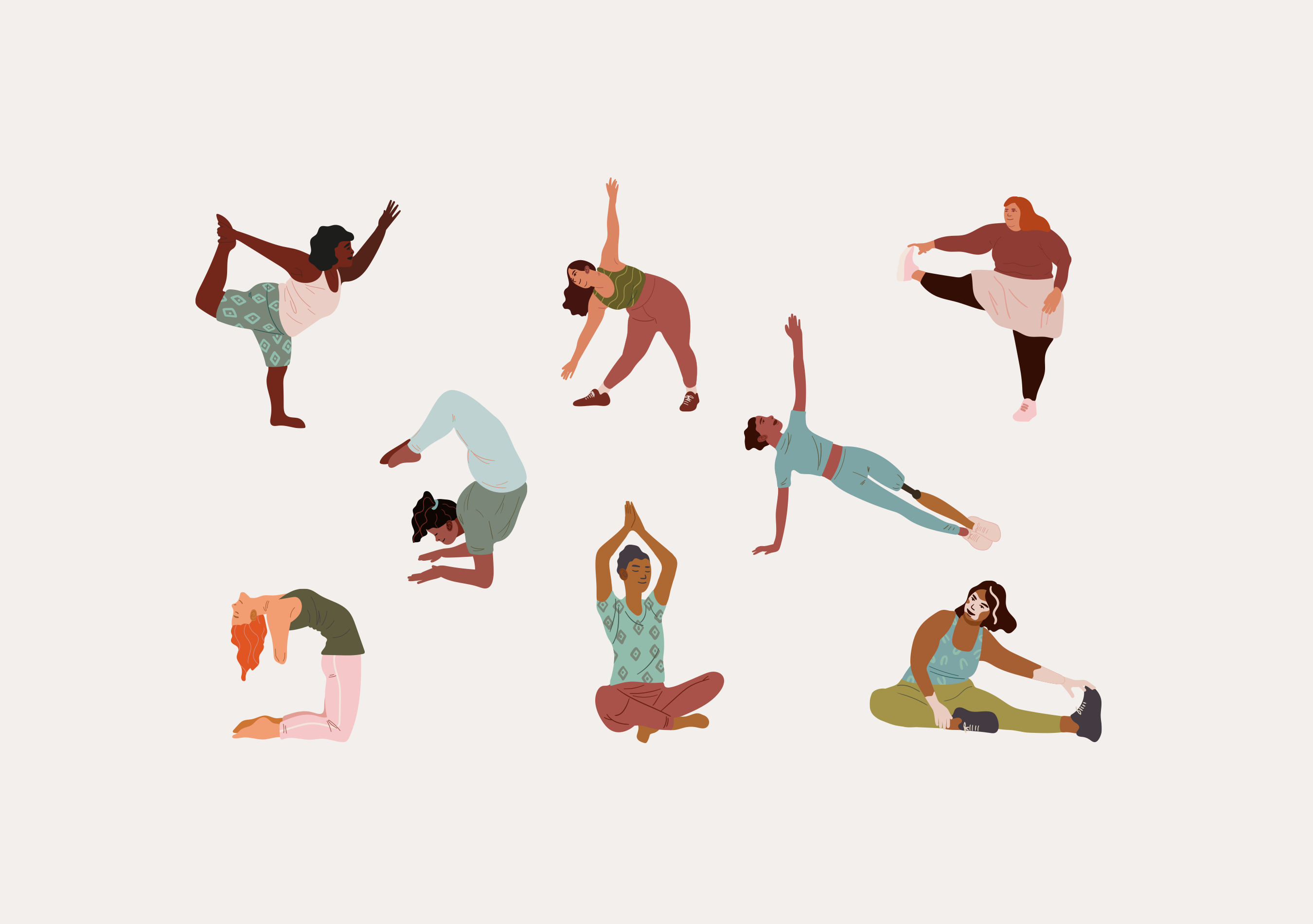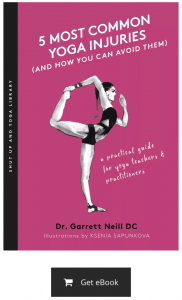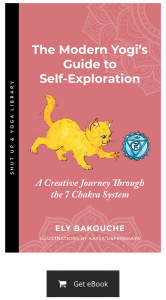In part I of this series on yoga & inclusion, we left off with a big question: how, as teachers, can we foster inclusive yoga spaces, both virtual and in-person? In this article, we’ll explore ideas on how you can actively commit to inclusion in your teaching practice. Keep in mind that inclusion is an ongoing process that requires a commitment to continual learning. No yoga space will be perfect, but if you strive to foster an inclusive environment, both you and your students will reap the rewards.
Physical space
It all starts with setting up a space that is physically accessible, welcoming, and comfortable. If your space is not on ground level, a ramp and automatic door will ensure that students using a wheelchair, cane, walker, or other mobility device can access the space. Many local companies like Toronto’s StopGap have created solutions to the frustrating one-step entrance common in older buildings. A spacious lobby, changing areas, and restrooms will ensure that all students can get ready for class. Ask yourself if there are any advantages to “female” and “male” gendered areas, and consider gender-inclusive areas with private spaces for using the restroom and changing. If you have the financial resources and storage space, it’s nice to lend out mats and basic props (wood, cork or foam blocks, bolsters, straps, blankets) so that all students can feel supported in their practice.
Next, think about the studio’s literature, website, and social media. What words and images are you using? Do students across races, gender identities, and body types see themselves reflected? Do your instructors reflect the demographic characteristics of your studio’s location? If not, why? When it comes to scheduling, do you offer diverse classes throughout the week? For example, offering a regular pay-what-you-wish class for BIPOC students is great – but what if a student can never make that time? Is the class then really for them?
Finally, ask yourself how students get to the studio: what are the transportation options? Are there public transit stops nearby? Is there accessible transit service (such as Toronto’s Wheel-Trans) running during the times before and after your classes? Are there convenient parking spots for vehicles and bikes (including cargo bikes)? If some of your students have personal support workers (PSWs), make sure to communicate this to your staff so they understand how to accommodate them. Do your due diligence and when in doubt, ask! Don’t place the burden on a student to explain what they need in a space where you inherently hold power as a teacher.
Financial accessibility
This is a big one. Yoga studios have narrow profit margins (and the pandemic has weighed heavily on smaller studios who have had to drastically reduce class sizes and increase time between classes for sanitation), making it challenging to offer reduced class rates. Students will understand this crunch, but do what you can to be clear about your pricing and offer options for students who can’t pay $20+ for a drop-in class. Virtual classes can help fill a gap between higher-cost in-person classes. Many studios such as Vancouver’s One Yoga use a pay-what-you-wish model, allowing students to access online classes at a rate that feels doable and without having to commit to a more expensive package of classes.
Of course, sliding scale payment can still be a hurdle, particularly if you need a credit card to sign up, as is the case for studios using Mind Body Online or similar booking platforms. When possible, allow students to pay for in-person classes with cash and offer a discreet way to provide payment. This past summer, when it was possible to offer small, distanced outdoor yoga, many teachers got creative with payment options, ranging from bartering to a ‘pass-the-hat’ payment system to asking students to e-transfer funds directly to the teacher or contribute to a charity.
Language and cueing
This is another important consideration that, in my opinion, should be given more attention in yoga teacher training. Cueing is hard! You want to find the balance between offering clear guidance and empowering students to own their practice. Recognize different learning styles, from visual to kinesthetic to verbal. Observe how your students are reacting to your cues, and if you sense confusion, find a different way to express yourself. Never be so tied to a planned sequence that you freeze when you need to adapt and modify based on how your students are moving and breathing. Depending on your class size and how well you know your students, offer personal suggestions as appropriate. If you’re teaching online, a combination of precise verbal cues and demonstrations is often best, as students cannot see the person next to them and may rely more on the teacher’s guidance.
Generally speaking, use person-first (for example, a person who uses a wheelchair, a person who is lower-income) rather than identity-first language, which can put a person’s situation/diagnosis/disability at the forefront. Keep in mind that language is personal and that there are no hard-and-fast-rules: it’s about using your best judgment and asking questions to ensure you’re referring to your students in the way that they prefer. It’s not about walking on eggshells, but rather being curious and respectful. If you make a mistake, such as incorrectly assuming a student’s gender, apologize directly and don’t repeat it.
When guiding students through an asana practice, remember that function is far more important than form: it doesn’t matter what a pose looks like as long as it doesn’t cause pain or discomfort. What’s important is creating a positive effect in the body. Avoid hierarchical language that attaches value to more ‘advanced’ variations. Suggest variations and let students choose which one resonates. Alignment is important, but don’t rely on anatomical terms especially if you’re teaching students who are newer to yoga or have different levels of body awareness.
Personal connection
Last but not least, integrate personal connection into your teaching practice. Humans are social beings and we benefit from personal attention. You can’t always do this with every single student; it’s important to maintain boundaries and prioritize giving within your energetic limitations. One simple action is to commit to learning your students’ names. I remember the first time a teacher addressed me by name before class, I felt this swell of gratitude for being recognized.
When it comes to getting to know your students’ practice, ask, don’t assume. Everyone makes mistakes, but don’t let fear of being wrong prevent you from learning what you need to keep your students safe. You don’t need to be intrusive: only ask what you need to know and invite students to share as much or as little about their needs as they wish to.
Grounding your yoga practice in inclusion may feel overwhelming. It requires active listening, learning, and reciprocity. If you’re a newer teacher (like me), think about the positive effects you’ve experienced from yoga and what approaches teachers have used to contribute to those experiences. When in doubt, ask questions, do your research, and own up to mistakes – not by retreating in shame, but by committing to continually do better.
This commitment to inclusion will always lead to a better experience for your students. All of the teachers I interviewed for this series shared the wealth of positive feedback they’ve received: even with the saturation of online classes, their students are coming back week after week because they feel seen, heard, and recognized. That sense of motivation, self-esteem, empowerment is impossible to measure, but it is what keeps our yoga communities strong and supportive, so that we can uplift each other, especially when the future of in-person yoga feels hazy.
The beautiful thing about using an inclusive lens for all aspects of yoga teaching is that it benefits EVERYONE, including the teacher. I had an interesting experience at a community-oriented yoga studio in Vancouver where a person entered the space for the first time wanting to join a class. They were initially agitated, dropping their belongings on the ground and loudly asking questions of the front desk staff as the class was supposed to start. There was an initial sense of discomfort pervading the practice room, but the teacher simply took a moment to chat with the student to set expectations for the class and quietly checked in with them throughout. Ultimately, we all benefited from a safe and nourishing practice where everyone was empowered to move and breathe in a way that was right for them. After class, I overheard the new student chatting with the teacher about mindfulness practices to help manage their stress and anxiety. I can imagine that many other studios may have turned away this student and missed out on a chance to connect and learn from each other.
And isn’t that the ultimate purpose of yoga – to find the unifying thread that connects us, regardless of where we came from and where we are going?
Edited by Ely Bakouche






